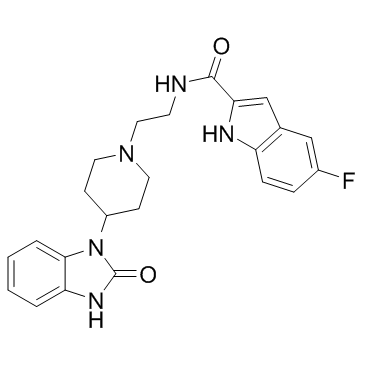| Description |
FIPI is a derivative of halopemide which potently inhibits both PLD1 and PLD2 with IC50s of 25 nM and 20 nM, respectively.
|
| Related Catalog |
|
| Target |
IC50: 25 nM (PLD1), 20 nM (PLD2)
|
| In Vitro |
Despite the high clearance of greater than 2 L/h/kg, FIPI shows a half-life of greater than 5 h, a Cmax of greater than 10-fold the 50 versus PLD2, and moderate bioavailability of 18%[1]. FIPI inhibits both PLD1 and PLD2 in a dose-dependent manner, with 50% loss of activity observed at approximately 25 nM. FIPI is not an irreversible suicide inhibitor but neither is it rapidly and completely reverses upon removal of the drug. IPI does not alter PLD subcellular localization, access to PIP2, actin stress fibers, or upstream signaling events. FIPI rescues PLD2-suppressed membrane ruffling and cell spreading[2]. FIPI attenuats the thimerosal-induced PLD activation, and the Hg-induced PLD activation in MAECs in a dose-dependent manner, and the agonist- and oxidant-induced PLD activation in a dose-dependent manner in MAECs[3].
|
| Kinase Assay |
Phospholipase D activity is quantified using our established method of measuring the formation of [32P]-radiolabeled PBt. Cellular lipids are extracted and PBt is isolated using our published methods of lipid extraction and thin layer chromatographic separation, respectively. Radioactivity is measured using liquid scintillation counting and quantified as DPM normalized to 106 counts in the total cellular lipid extract or as percentage of control (vehicle-treated cells).
|
| Cell Assay |
Cytotoxicity in MAECs is determined by assaying the extent of reduction in MTT in intact cells using the commercial MTT reduction assay kit. At the end of the experimental treatments, MTT solution (10% vol/vol in MEM) is added and the cells are incubated for 3 hours, following which MTT solvent is added in an amount equal to the original culture volume. Absorbance of the reduced MTT is determined spectrophotometrically, according to the manufacturer's recommendations.
|
| References |
[1]. Monovich L, et al. Optimization of halopemide for phospholipase D2 inhibition. Bioorg Med Chem Lett. 2007 Apr 15;17(8):2310-1. [2]. Su W, et al. 5-Fluoro-2-indolyl des-chlorohalopemide (FIPI), a phospholipase D pharmacological inhibitor that alters cell spreading and inhibits chemotaxis. Mol Pharmacol. 2009 Mar;75(3):437-46. [3]. Secor JD, et al. Novel lipid-soluble thiol-redox antioxidant and heavy metal chelator, N,N'-bis(2-mercaptoethyl)isophthalamide (NBMI) and phospholipase D-specific inhibitor, 5-fluoro-2-indolyl des-chlorohalopemide (FIPI) attenuate mercury-induced lipid si
|
